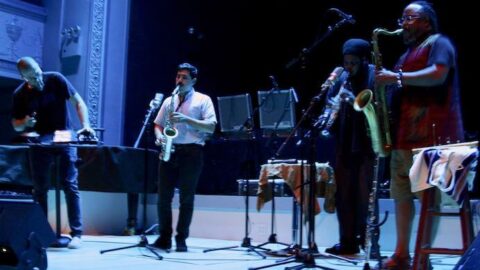On Wednesday, September 19, 2018, New York’s downtown music scene was invigorated by a fresh and eclectic infusion of Baltimore area musicians, gathered within the hallowed proscenium-sanctum of Brooklyn’s Roulette Intermedium. This special group of individuals was on tour to celebrate the twentieth anniversary of High Zero, the East Coast’s preeminent festival of improvised, experimental music. Emerging in 1999 from The Red Room—an experimental music venue established in 1996 and nestled in the back of Normals Books in Baltimore’s Waverly neighborhood—High Zero was an answer to a call from destiny that grew out of the unexpected enthusiasm Baltimore concertgoers were emoting for unorthodox sounds and out-of-bounds music. At the time of High Zero’s inception, saxophonist John Berndt remarked, “It seemed like the right time to do something like this.”
While High Zero’s origin and core collective of performers hail from Baltimore (a testament again “to the depth of Baltimore’s experimental music subculture”), to say the festival is based there or anywhere would sell short its thoughtful mission of organizing collaborations between internationally-recognized musicians and ascending newcomers from all over the map, “united by their commitment to the musical imagination.” The result is an evolving chorus of musical storytellers, mediated by that exciting Baltimore community so dedicated to the spontaneous creation of new music, which has grown and remained innovative with amoebic efficiency over the festival’s twenty-year history.
In keeping with the festival’s tradition, Wednesday night’s performance was presented in four distinct sets, each staffed by a unique lineup of players. Hosted by the charmingly effervescent M. C. Schmidt (a member-performer of the High Zero collective and notably one half of the electronic music duo Matmos), the evening’s simple format moved along fluidly and felt thoughtfully-curated and well-organized from end to end. Schmidt kept the tone lighthearted and positive, layering his insightful commentary between sets with admittedly corny jokes as the stage was modified to accommodate each group. Special note was made of the locality of each player (who was based in New York and who was imported from Baltimore), while reminding the audience that none of the players had ever performed together in these combinations before.

Tom Boram (Baltimore: electronics, computer, harpsichord), Ikue Mori (New York: electronics) and C. Spencer Yeh (New York: voice, violin) comprised the first group, and produced a kinetic, driving sonority punctuated by tin clusters from the harpsichord over a velvet droning texture established by the violin and broadened by watery cascades of electronic sounds. In a climactic moment, Yeh held a bow in each hand, producing long tones from his violin by bowing in circular waves over the finger board and by the bridge.
In group two, Owen Gardner (Baltimore: cello), Margaret Schedel (New York: cello, electronics) and Shelly Purdy (Baltimore: percussion) spun a web of interesting sounds on a more acoustic plane driven largely by Purdy’s use of found objects and unconventional percussion (in one instance a copper-bottom saucepan modified with metal tines like an mbira emanated ethereal twangs into the hall).
Group three transcended to an even broader sonic sphere, introducing reeds and woodwinds to the night’s expanding paradigm in combination with further innovation with electronics and percussion. Jamal Moore (Baltimore: reeds), Jeff Carey (New York: computer), Ras Moshe (New York: saxophone), JD Parran (New York: woodwinds, percussion) and Andrew Bernstein (Baltimore: saxophone) wove a tapestry of patterns and tones that was immediate and compelling, channeling specters of Don Cherry, Moondog, and Harry Partch like a woodwind Ouija board, with shades of Anthony Braxton and La Monte Young hovering throughout. Carey’s computer work enhanced the stoic physicality of the group with dance-like movements emphasizing the motion of his joystick computer controller, which—mounted on a teetering music stand—gave the impression he was guiding a flight simulator through the peaks and valleys of the emerging composition.

The final ensemble offered no less of a compelling performance, with Carey’s kinetic computer control mirrored by New York based percussionist Michael Evans‘ near acrobatic movements as he tossed objects in the air, paced about with cymbals and gongs strung around his neck, swung microphones around like lassos and lurched around a stand-mounted theremin, coaxing bursts of energetic sounds from surrounding floor monitors. In combination with haunting, animal-like groans and shrieks from Baltimore-based Samuel Burt‘s daxophone (a bizarre, wooden-electronic instrument played with a bow) and New Yorker Lea Bertucci (bass clarinet, alto sax and electronics), the trio achieved an orchestral scale to their sonority that closed out the evening with subtle intensity.
Improvisation is a strange and wonderful thing. Michelangelo famously said, “Every block of stone has a statue inside it and it is the task of the sculptor to discover it; I saw the angel in the marble, and carved until I set him free.” Whether or not the master was referring to a type of improvisatory process, maybe every performance space is like Michelangelo’s marble block, and in every hall, between every combination of players (maybe under every full moon or lucky star), there is a new work of art ready to be revealed rather than simply devised and executed. As Miles Davis is reputed to have said, “Don’t play what’s there, play what’s not there,” and indeed what the members and guests of High Zero distilled from the ether on Wednesday night exceeded all expectations of what might have been, with an undulating vibrancy that brought to life what could have been, like some rare or unstable element that flickered in and out of existence only for an instant.
























